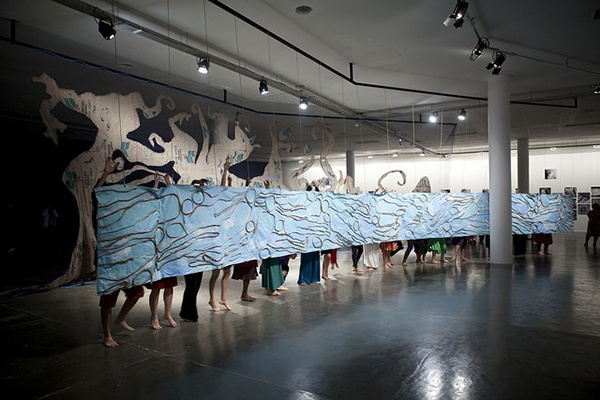"Painting, Performance, Politics": primeira retrospectiva de El Hadji Sy
Published19 Feb 2015

Imagem: 31ª Bienal de São Paulo, 2014
Painting, Performance, Politics é a primeira retrospectiva do artista e curador nascido em Dakar em 1954, El Hadji Sy, Weltkulturen Museum, em Frankfurt, a partir de 5 de Março.Conhecido pelo seu activismo, a sua obra tem questionado o status quo político. Em 1980 criou o espaço Tenq, um termo que significa 'articulação' e tem sido um membro activo do laboratório AGIT’ART desde a sua fundação nos anos 70.
O site Contemporay and entrevista-o, a dias da inauguração.
JG: Senghor is famous for having initiated a tapestry manufactory in Dakar and later at Thiès. How much did it influence you as a young artist?
EHS: In the 1960s and 1970s, many artists made maquettes – designs – to be woven into tapestries, and the Senegalese government bought them. Firstly, I didn’t like this form of exploitation of the artist and their ideas, their creativity. Secondly, I am more of a fresco person. I’ve done works that are sometimes 40m long. You can’t do that with tapestries. I also build large canvases from the bags once used to contain rice, sugar or coffee. They have different a porosity and aren’t treated in the same way as industrial canvas. And unlike murals or mosaics, I can take them off the wall and put them up wherever I want. I like the idea of transforming a classified material and uplifting it into something more precious, more noble.
JG: But when I look at the way you hang some of your paintings on the wall, on wooden bars, it definitely has the style and aesthetic of tapestry…
EHS: Yes, but I mock it! I perform a critique of tapestry.
JG: You play with the aspect of the artwork as a fluid, mobile, performative structure. In the show, we see paintings as movable screens, kites hanging from the ceiling, banners placed outside the museum that move with the wind, and other canvases that lie on the ground like carpets. Is it important for you to literally spread your work across diverse locations, from the museum into the street?
EHS: Yes, it’s never just about one place. That’s why I am not too fond of the limited space of a gallery environment. When I think of exhibiting, I imagine sitting in a truck that contains all my work and driving to a small village and stopping at the marketplace because it is a public space. I start to install my art and people can approach it and enjoy it. That’s my idea of the mobility of art. I always loved the circus for its ability to appear out of nowhere, unfold everything at the marketplace, do something, enchant people, and disappear again. It’s not about one fixed location.
A entrevista completa, aqui
